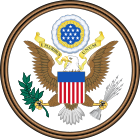- National Aeronautics and Space Act
-
National Aeronautics and Space Act of 1958 
Citations Public Law Pub. L. No. 85-568 Stat. 72 Stat. 426 Codification Legislative history - Introduced in the House as H.R. 12575 by on
- Committee consideration by: House Select Committee on Astronautics and Space Exploration
- Signed into law by President Dwight D. Eisenhower on 29 July 1958
Major amendments Relevant Supreme Court cases None The National Aeronautics and Space Act (Pub.L. 85-568) is the United States federal statute that created the National Aeronautics and Space Administration (NASA). The Act, which followed close on the heels of the Soviet Union's launch of Sputnik, was drafted by the United States House Select Committee on Astronautics and Space Exploration and on July 29, 1958 was signed by President Eisenhower. Prior to enactment, the responsibility for space exploration was deemed primarily a military venture, in line with the Soviet model that had launched the first orbital satellite. In large measure, the Act was prompted by the lack of response by a US military infrastructure that seemed incapable of keeping up the space race.
The act specifically charged the new Agency with eight objectives, including “the establishment of long-range studies of the potential benefits to be gained from, the opportunities for, and the problems involved in the utilization of aeronautical and space activities for peaceful and scientific purposes.”[1]
In addition to creating NASA, the Act abolished the previously created National Advisory Committee for Aeronautics, effective October 1, 1958. The Act also created a Civilian-Military Advisory Panel, based thereafter at Vandenberg Air Force Base in California that would advise and coordinate the military uses of space. To this day, the United States has coordinated but separate military and civilian space programs, with much of the former involved in launching military and surveillance craft and, prior to the Partial Test Ban Treaty, planning counter-measures to the anticipated Soviet launch of nuclear warheads into space.
In addition, the new law made extensive modifications to the patent law and provided that both employee inventions as well as private contractor innovations brought about through space travel would be subject to government ownership. By making the government the exclusive provider of space transport, the act effectively discouraged the private development of space travel. This situation endured until the law was modified by the Commercial Space Launch Act of 1984, enacted to allow civilian use of NASA systems in launching space vehicles.[2]
The Apollo mantra, "We came in peace for all mankind", as inscribed on the Eagle's Lunar Module plaque, is derived from the Act's "declaration of policy and purpose":
- The Congress hereby declares that it is the policy of the United States that activities in space should be devoted to peaceful purposes for the benefit of all mankind.[3]
The Act was subsequently amended to remove gender bias, so that this policy statement now reads:
- Devotion of Space Activities to Peaceful Purposes for Benefit of All Humankind.--Congress declares that it is the policy of the United States that activities in space should be devoted to peaceful purposes for the benefit of all humankind.[4]
See also
References
- ^ Dick, Steven J.; Launius, Roger D.. "Societal Impact of Spaceflight". NASA. NASA Technical Reports Server. http://hdl.handle.net/2060/20080007234. Retrieved 27 September 2011.
- ^ http://www.space.edu/LibraryResearch/565TP.html
- ^ The National Aeronautics and Space Act (unamended)
- ^ The National Aeronautics and Space Act
External links
- Text of the National Aeronautics and Space Act, via NASA.gov
- Overview of Congressional Committee testimony prior to enactment
- Dwight D. Eisenhower memorandum to Defense Department regarding creation of NASA and military's role
- History of U.S. national space policy
Categories:- 1958 in law
- NASA oversight
- United States federal legislation
- 85th United States Congress
- United States federal legislation stubs
Wikimedia Foundation. 2010.

